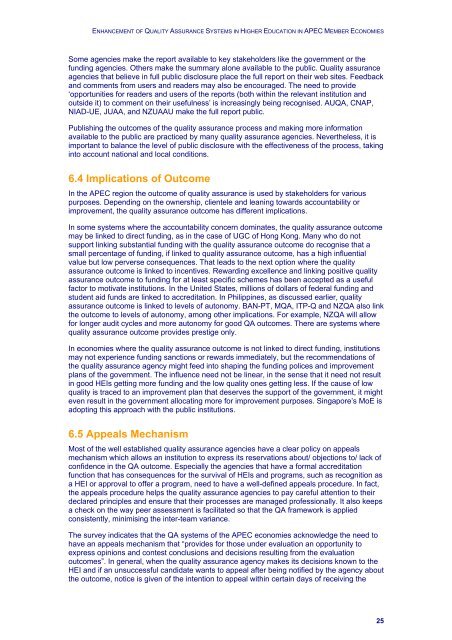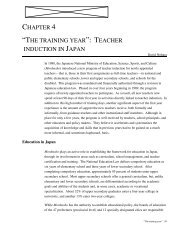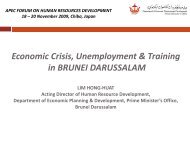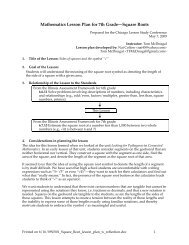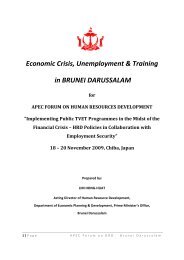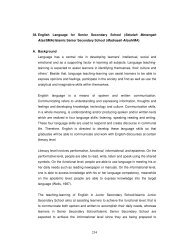Quality Assurance Systems in Asia-Pacific Economic Cooperation
Quality Assurance Systems in Asia-Pacific Economic Cooperation
Quality Assurance Systems in Asia-Pacific Economic Cooperation
Create successful ePaper yourself
Turn your PDF publications into a flip-book with our unique Google optimized e-Paper software.
ENHANCEMENT OF QUALITY ASSURANCE SYSTEMS IN HIGHER EDUCATION IN APEC MEMBER ECONOMIES<br />
Some agencies make the report available to key stakeholders like the government or the<br />
fund<strong>in</strong>g agencies. Others make the summary alone available to the public. <strong>Quality</strong> assurance<br />
agencies that believe <strong>in</strong> full public disclosure place the full report on their web sites. Feedback<br />
and comments from users and readers may also be encouraged. The need to provide<br />
‘opportunities for readers and users of the reports (both with<strong>in</strong> the relevant <strong>in</strong>stitution and<br />
outside it) to comment on their usefulness’ is <strong>in</strong>creas<strong>in</strong>gly be<strong>in</strong>g recognised. AUQA, CNAP,<br />
NIAD-UE, JUAA, and NZUAAU make the full report public.<br />
Publish<strong>in</strong>g the outcomes of the quality assurance process and mak<strong>in</strong>g more <strong>in</strong>formation<br />
available to the public are practiced by many quality assurance agencies. Nevertheless, it is<br />
important to balance the level of public disclosure with the effectiveness of the process, tak<strong>in</strong>g<br />
<strong>in</strong>to account national and local conditions.<br />
6.4 Implications of Outcome<br />
In the APEC region the outcome of quality assurance is used by stakeholders for various<br />
purposes. Depend<strong>in</strong>g on the ownership, clientele and lean<strong>in</strong>g towards accountability or<br />
improvement, the quality assurance outcome has different implications.<br />
In some systems where the accountability concern dom<strong>in</strong>ates, the quality assurance outcome<br />
may be l<strong>in</strong>ked to direct fund<strong>in</strong>g, as <strong>in</strong> the case of UGC of Hong Kong. Many who do not<br />
support l<strong>in</strong>k<strong>in</strong>g substantial fund<strong>in</strong>g with the quality assurance outcome do recognise that a<br />
small percentage of fund<strong>in</strong>g, if l<strong>in</strong>ked to quality assurance outcome, has a high <strong>in</strong>fluential<br />
value but low perverse consequences. That leads to the next option where the quality<br />
assurance outcome is l<strong>in</strong>ked to <strong>in</strong>centives. Reward<strong>in</strong>g excellence and l<strong>in</strong>k<strong>in</strong>g positive quality<br />
assurance outcome to fund<strong>in</strong>g for at least specific schemes has been accepted as a useful<br />
factor to motivate <strong>in</strong>stitutions. In the United States, millions of dollars of federal fund<strong>in</strong>g and<br />
student aid funds are l<strong>in</strong>ked to accreditation. In Philipp<strong>in</strong>es, as discussed earlier, quality<br />
assurance outcome is l<strong>in</strong>ked to levels of autonomy. BAN-PT, MQA, ITP-Q and NZQA also l<strong>in</strong>k<br />
the outcome to levels of autonomy, among other implications. For example, NZQA will allow<br />
for longer audit cycles and more autonomy for good QA outcomes. There are systems where<br />
quality assurance outcome provides prestige only.<br />
In economies where the quality assurance outcome is not l<strong>in</strong>ked to direct fund<strong>in</strong>g, <strong>in</strong>stitutions<br />
may not experience fund<strong>in</strong>g sanctions or rewards immediately, but the recommendations of<br />
the quality assurance agency might feed <strong>in</strong>to shap<strong>in</strong>g the fund<strong>in</strong>g polices and improvement<br />
plans of the government. The <strong>in</strong>fluence need not be l<strong>in</strong>ear, <strong>in</strong> the sense that it need not result<br />
<strong>in</strong> good HEIs gett<strong>in</strong>g more fund<strong>in</strong>g and the low quality ones gett<strong>in</strong>g less. If the cause of low<br />
quality is traced to an improvement plan that deserves the support of the government, it might<br />
even result <strong>in</strong> the government allocat<strong>in</strong>g more for improvement purposes. S<strong>in</strong>gapore’s MoE is<br />
adopt<strong>in</strong>g this approach with the public <strong>in</strong>stitutions.<br />
6.5 Appeals Mechanism<br />
Most of the well established quality assurance agencies have a clear policy on appeals<br />
mechanism which allows an <strong>in</strong>stitution to express its reservations about/ objections to/ lack of<br />
confidence <strong>in</strong> the QA outcome. Especially the agencies that have a formal accreditation<br />
function that has consequences for the survival of HEIs and programs, such as recognition as<br />
a HEI or approval to offer a program, need to have a well-def<strong>in</strong>ed appeals procedure. In fact,<br />
the appeals procedure helps the quality assurance agencies to pay careful attention to their<br />
declared pr<strong>in</strong>ciples and ensure that their processes are managed professionally. It also keeps<br />
a check on the way peer assessment is facilitated so that the QA framework is applied<br />
consistently, m<strong>in</strong>imis<strong>in</strong>g the <strong>in</strong>ter-team variance.<br />
The survey <strong>in</strong>dicates that the QA systems of the APEC economies acknowledge the need to<br />
have an appeals mechanism that “provides for those under evaluation an opportunity to<br />
express op<strong>in</strong>ions and contest conclusions and decisions result<strong>in</strong>g from the evaluation<br />
outcomes”. In general, when the quality assurance agency makes its decisions known to the<br />
HEI and if an unsuccessful candidate wants to appeal after be<strong>in</strong>g notified by the agency about<br />
the outcome, notice is given of the <strong>in</strong>tention to appeal with<strong>in</strong> certa<strong>in</strong> days of receiv<strong>in</strong>g the<br />
25


